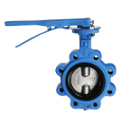
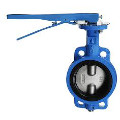

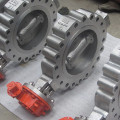
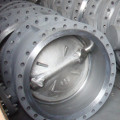
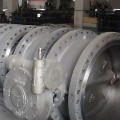
Butterfly valves are particularly suitable for high flow rates and intermediate pressures. They have wide open passage areas and herefore creqate almost negligeable pressure drop. In our patented model, the typical drawback of poor sealing is removed and a perfect airight design is provided for any operating pressure, even in large units.
These characteristics extend the range of use of the butterfly valves to new fields of application, such as operation with compressed air, gas, vacuum, in which a very good performance is achieved. Of course even better performance is obtained with oils fuels, and all liquids.
However, particular care must be paid to hard waters that may impair the valve sealing or its operations by depositing scales on the sealing elements.
Both operations of valve opening and closure are rapid and take place within one quartet turn of input lever only. The position of the lever itself provides an indication of the angular position of the butterfly and therefore of the open flow passage area. In addition to the end stops of the input mechanism of the butterfly, an inernal device provides a precise stop when the valve closes, and thus maintains the correct positioning of the butterfly and a perfect sealing. The operating torque of our valves is extremely small, because the seals are mounted on the valve body and do not undergo any friction during the disc rotation, after the valve is close, only, the fluid pressure keeps the seals of the body against the spherical surface of the butterfly, thus providing perfect sealing.
Therefore, the maximum operating torque is required at the beginning of the valve opening, i.e. when the seals are in contact with the whole butterfly-lenght.
The fluid flow is always bidirectional and the pressure drop through the valve is negligeable due to the wide open passage area.
For an open valave angle larger than 20°, the induced flow turbulence is very small, therefore butterfly valves can be used as modulating valves when the accurancy requirements are not too stringent. For the use as flow modulating device, our valves are equipped with a locking system that allows to lock the butterfly in any position.
When the valve is used as modulating valve for luids, it is necessary to keep the fluids speed under 6 min\sec. Positive features of our butterfly vaves are compactness, strenght, lightness and minimum distance between welding ends when compared to other valves of the same diameter. Thus, they can often be installed where no other valve could fit.
Because any metal contact between the components is avoided, the valve doen not undergo any decrease of its characteristics. Only the seals may have to be replaced, which is a very easy and quick operation.
The seals can be made of different materials, according to the operating conditions, High temeprature is the most critical and limiting factor, which is common for all valves with seals.
Due to their easy operation, butterfly valves are highly suitable to be driven by light and aompact servos and can be used as parts of emergency operation systems with pneumatic or electromegnetic inputs.
All our valves are equipped with flanges to be welded directly to the connecting pipes, while it is always possible to disassemble the main body for inspection and replacement of the seals.
Materials
In the standard version the valve is made out of forged carbon steel or ductile iron; the stem is of stainless steel and he spherical surface of the butterfly is chrome plated.
On request the valves can be also made out of stainless steel, bronze or other materials. Seals are the BUNA N , EPDM or Viton type according to the operating conditions.
- Buna N is used for air, methan, oxigene, nitrogen, water, oils, and for temperatures up to 80 °C.
- EPDM (Dutal) is used for air, water, water steam, inorganic acids and temperatures up to 150 °C.
- Viton is used for diesel oil, gasoline, kerosene, liquid gases, city gas and for temperatures up to 200.
